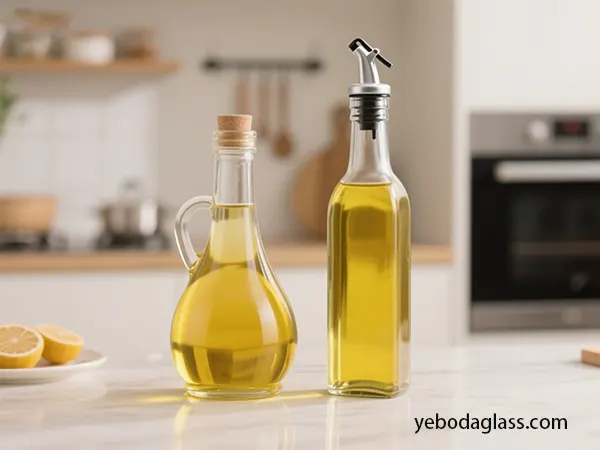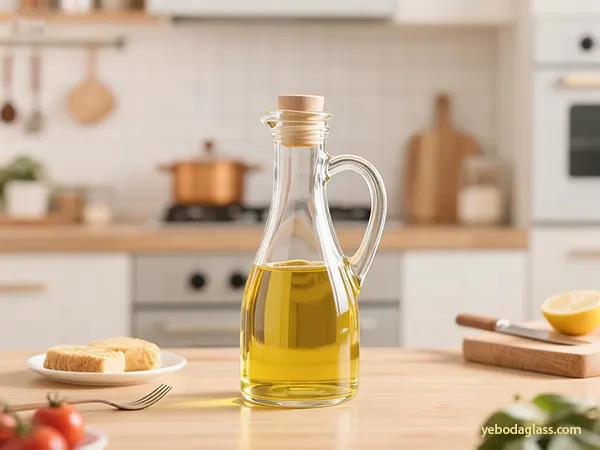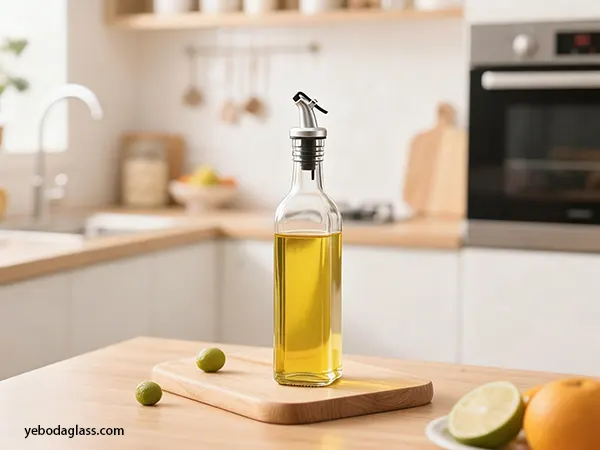giriiş
In today’s competitive consumer goods market, the oil dispenser bottle has evolved far beyond a simple vessel for storing cooking oils. It has become an important marketing tool and brand ambassador. Packaging not only ensures safe control, but also describes identification, functionality and values. For producers and retailers, a well -designed oil bottle brand drives the brand discrimination and consumer loyalty. The early impression of a product is often defined by its packaging. A sleek, durable, and well-functioning glass oil dispenser bottle conveys premium quality, reliability, and modern sophistication. Brands like Evet, evet. oil dispenser bottle demonstrate how innovation in design and user-focused engineering can elevate everyday kitchen products into lifestyle accessories. By solving consumer frustrations such as dripping or messy pouring, Yeboda shows that thoughtful packaging is just as important as the oil inside. At the same time, cam şişeler represent sustainability, transparency, and trust—values increasingly prioritized by today’s health-conscious and eco-driven shoppers. For example, the Yeboda oil dispenser bottle not only looks clean and minimal but also integrates a superior anti-drip system that enhances usability while reinforcing premium positioning. Such features prove that packaging design is both functional and symbolic, bridging consumer expectations with product experience.

Defining Shelf Appeal and Its Drivers in the Oil Category
Shelf appeals for an oil dispenser’s bottle, the ability to draw attention to the point of sales and selling of sale from visual, touch and cognitive factors. Major drivers include:
- Visual dominance: stands out with unique shapes, colors and labeling.
- Brand recognition and belief: familiar and consistent, attractive packaging.
- Recognized quality and price: Mention of product quality from design.
- Emotional relations: developing aligned feelings with consumer aspirations.
- Clarity and information hierarchy: easily digestible information.
- Functional promise: Visual signals suggest ease of use or remove benefits.
Matrix such as i-tracking, consumer survey, and A/B test (detailed in section 7) determine this effect, important for design optimization.
Beauty Design Innovation: Drawing Attention and Expressing Brand Identity
Beauty design is an early consumer touchpoint, which is important for discrimination and brand identity. Innovations include:
- Unique bottle figures: sculpture form, ergonomic figure, or immediate recognition and abstract shape for better grip.
- Color straps and transparency: protective dark glass, transparent glass for purity, or sophisticated mats/frosted effects.
- Labeling and graphic designs: minimal design, complex illustration, bold typography, and touch label (embossed, texture).
- Material finish: Matte for shiny, organic experience for modernity, or metal/wood/cork accents for luxury.
The strategic combination of these elements makes an oil dispenser bottle craft that attracts attention and communicates brand values effectively.
Functional Design Innovations: Enhancing User Experience and Perceived Value
While the aesthetics attract, functional design innovation creates loyalty and perceived value. A beautiful but hard-to-use bottle quickly loses the appeal. Innovation focuses on improving ergonomics, handling and dispensing mechanisms, directly user enhances satisfaction.
- Ergonomic correction: Better grip (indentation, texture), balanced weight and efficient storage shapes.
- Handling with intuitive knowledge: one-hand operation and clear volume indicators.
- Addressing normal pain points for user satisfaction: Anti-drip sputinity (sharp cut-off, returns channel), controlled por mechanism (flow restrictive, push-button, measured dispensing), sprayers/mists and pump dispenser.
Permanent and Smart Design: Align with Modern Consumer Values
Modern consumers seek aligned products with health and environmental values. Innovative oil dispenser bottle design stability and smart features:
- Environmentally friendly materials: recycled materials (PCR Glass/PET), using bioplastics (plant-based), and reduces lightweight environmental effects.
- Refilable system: Getting traction, this model uses bulk containers to re-fill durable primary bottles, reduces single-use waste and promotes loyalty.
- Smart features and connectivity: Emerging trend includes integrated sensor (betting) for tracking (speculative), accurate dose control, NFC/QR code for detailed product information (original, nutrition, stability, experience), and temperature sensing for quality protection.
These innovation fulfill the preferences to develop, positioning brands as further thinking and responsible.

Tayloring Design for Diverse Market Segments and Retail Channels
Effective oil dispenser bottle design requires strategic adaptation for diverse market segment
Market Segments:
- Premium: luxury, specificity (heavy dark glass, minimum label, unique closure, artisan focus).
- Mass-marketing: strength, practicality, comprehensive appeal (cost-affect material, clear lively label, reliableness).
- Health-conscious: transparency, naturalness, health benefits (clear glass, biological certificates, environmentally friendly material).
Continuous ecological responsibility (recycled materials, recycled design, refillable system, stability message).
Retail Channel:
- Physical supermarkets: strong view effect, bold color, specific shape, strong design for congestion corridors.
- Special stores/boutiques: unique design for complex, artisan, sensible consumers.
- Online platforms (e-commerce): high quality digital imagery, identifiable thumbnail, safe transit packaging, clear details.
- Direct-to-Consumer (D2C): brand storytelling, personalized touch, unique unboxing, refill/subscription model.
The tailoring design ensures effective resonance with the target audience in all channels.
Shelf Appeal Quantity: Metrics and Measurement Strategies
It is important for strategy and investment to determine the impact of innovative oil dispenser bottle design. The mixture of quantitative and qualitative methods provides extensive effectiveness insight:
- Sales upliftment and market share increase: Pre-designed sales sell, track market share, and test market rollouts.
- Brand recognition and recall: Acmented/united recall studies, conduct i-tracking studies for visual attention, and shelf impact tests.
- Consumer assumption studies: Use surveys, focus group for direct response, inherent association tests for unconscious assumptions, and semantic differential scales for characteristic ratings.
- Wishes to pay (WTP) analysis: Plan the combination
Emerging Trends and Future Outlook in Oil Dispenser Design
The oil dispenser bottle design landscape is dynamic, shaped by materials, technology and consumer preferences. Major future trends include:
Advanced content science: bio-bought/biodegradable material (algae, fungi), self-healing polymer (betting), light composite, and increased barrier technologies for extended shelf life.
- Smart packaging technologies: Integrated IOT sensor (speculative) for freshness/use tracking, enhanced reality (AR) for immersive brand stories (AR), dynamic labeling (e-ink, OLED) to replace the content, and blockchain for unique transparency.
- Hyper-personalization and customization: On-demand printing (3D, digital) for custom labels/shapes, special design for membership boxes.
- Tüketici tercihlerinin geliştirilmesi: focusing on “naked” packaging/minimalism, health/welfare integration (dose control, nutrient protection), and intensive focus on circular economy principles (refill, recycle, recycle).
The future merges with aesthetics, functionality, stability and intelligence, which creates packaging, which appeals, responsible and integrated into the consumer lifestyle. The active brand will lead.

Conclusions and Strategic Recommendations for Market Benefits
Innovative oil dispenser bottle design is a primary driver of consumer choice and brand success, which integrates visual appeal, functionality, stability and smart technologies. Yeboda glass oil dispenser bottle gives examples of how beauty simplicity and better functional design (anti-drip, controlled knuckles) how to elevate the user experience and market appearance.
For Competitive Advantage, Brands Need:
- Invest in overall design thinking: Integrating stability from aesthetics, ergonomics and start, depending on the needs of the consumer.
- Priority to functional innovation: Developed and patented superior dispensing mechanisms (eg, anti-drip, accurate por) that solves consumer frustrations like Yeboda.
- Embrace stability: use environmentally friendly material, lightweight and refillable system; Communicate these efforts clearly.
- Leverage smart packaging: See NFC/QR code, AR experience, and increase future IOT sensors for engagement and discrimination.
- Tailor design: Create different designs for all retail channels customized premium, mass-market, health-conscious and durable segments.
- Design effects for data-operated refinement and ROI: Use strong metrics (sales, eye-tracking, survey, WTP).
- Emerging trends friendly: Use continuously with new materials, smart techniques and privatization to maintain market leadership.
These strategies turn the bottle of the oil dispenser into a powerful brand property, enhancing the shelf appeal, user satisfaction and competitive advantage.




